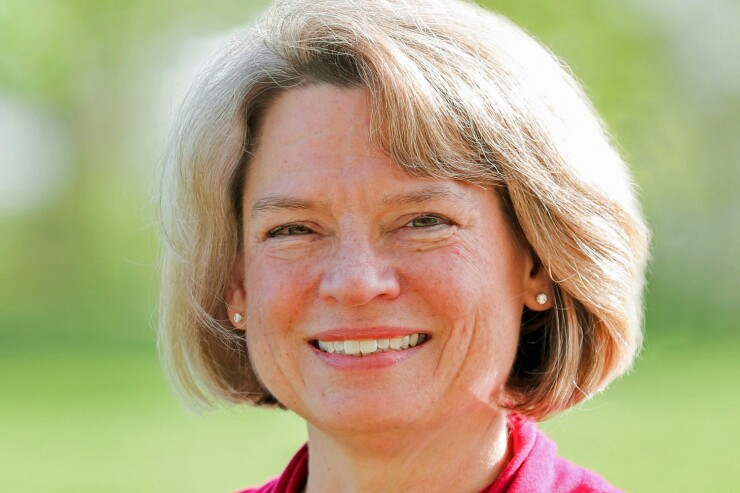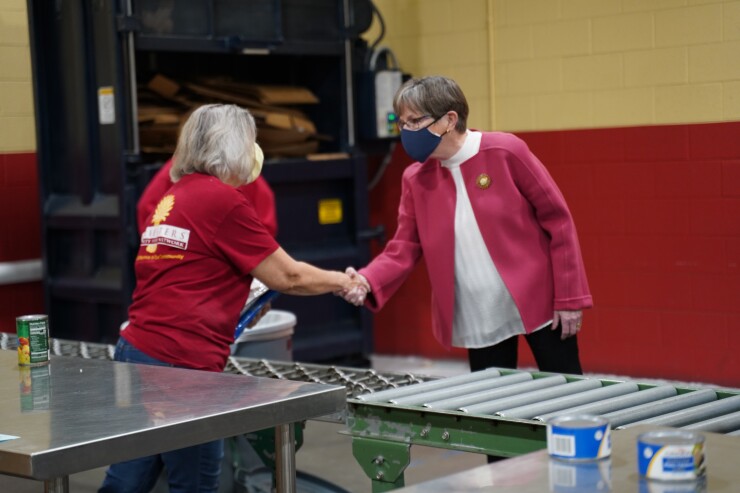Kansas Gov. Laura Kelly wants to “ax the tax” on groceries.
The Democrat has been pushing for the state's Republican-controlled legislature to eliminate the 6.5% tax since November, arguing that Kansas, with its biggest budget surplus in 40 years, is in a position to make the move.
"My administration has taken steps to restore the Kansas economy, and that fiscal responsibility has paved the way to provide direct tax relief to Kansans," Kelly said in a statement earlier this month. "I urge the legislature to work together to send me a clean bill eliminating the state’s tax on food immediately, so that we can put this money back into the pockets of Kansas taxpayers."

The grocery-tax cut drive in Kansas reflects a national trend — lawmakers in about 20 states are considering bills to permanently or temporarily ease the sales tax burden on their residents, according to the National Conference of State Legislatures.
Michael D'Arcy, a Fitch Ratings analyst, pointed to “huge” budget surpluses, high inflation, and the upcoming election as catalysts for the lengthy list of measures to cut sales taxes, as well as income and gasoline taxes.
“There’s a lot of pressure to return money to taxpayers,” he said. “So that may overcome a lot of caution in the legislatures.”
Donna Ginther, an economics professor at the University of Kansas and the chief academic advisor to the Governor’s Tax Reform Council, said Kansas has the nation’s second highest tax rate on food purchases, which gets even higher — close to 10% in some counties — with the addition of local taxes.
Kansas has an average sales tax rate of 8.7% including local taxes, according
“The state has the money," Ginther said. "We have a higher tax burden. Food is a necessity. Food inflation is going through the roof."
Kansas, which ended fiscal 2021 with a nearly $2.1 billion balance, took in $502.5 million in tax revenue last month, topping estimates by 3.9% and surpassing February 2021 collections by 10.2%. So far in fiscal 2022, which began July 1, tax revenue is 4% over estimate and 5.6% more than the same period in fiscal 2021, with sales and use taxes up 14.7% over the previous fiscal year.
Inflation-weary voters head to the polls in November to decide races for 36 governors and for 84% of the nation’s 7,383 state legislative seats, according to Ballotpedia.
Inflation is at a 40-year high, with the Consumer Price Index rising 7.9% in the 12 months through February. The cost of food purchased from grocery stores was up 8.6% year over year. Meanwhile, billions of dollars in federal pandemic aid and solid tax revenue growth have filled state coffers.
Total state tax revenue increased 19.4% in inflation-adjusted terms between April 2021 and January 2022 compared to the same period one year earlier with sales taxes up 16.7%, according to Lucy Dadayan, senior research associate at the Urban Institute.
She warned in her
Geoffrey Buswick, an analyst at S&P Global Ratings, said it’s not surprising sales tax revenue is robust, given that collections will naturally rise as prices escalate. He added there are no immediate credit concerns, particularly if sales tax cuts are temporary.
“It’s the longer-term ones coupled with the longer-term assumptions that could introduce credit risk if the assumptions are too aggressive,” he said, pointing out that a state might be cutting back revenue while locking in higher costs with multi-year labor contracts amid a worker shortage.
In Kansas, Kelly’s plan to wipe out the state sales tax rate on food as of July 1, 2022, would cost the state $443 million in fiscal 2023, growing to about $500 million in fiscal 2025, according to a legislative report on House Bill 2487, which is favored by the governor.
A Republican-sponsored measure, HB 2711, would cut the overall state sales tax rate to 6.3% and drop the state tax on food to 3.5% beginning July 1, with further reductions of 1.2% each year the budget stabilization fund exceeds $100 million until the rate hits 0%. The revenue hit would be $333 million in fiscal 2023.
Fitch's D'Arcy said the immediate elimination of the tax could have a big impact on the state’s budget, while a phased-in approach would probably be better absorbed.

In his Feb. 7 State of the State address, Oklahoma’s Republican governor, Kevin Stitt, also proposed ending his state’s tax on groceries.
“Oklahoma is one of just 13 states that taxes groceries, and ours is one of the highest,” he said. “Many Oklahomans are already struggling under the weight of record inflation. Let’s give them more help this year. Because, after all, we need more taxpayers, not more taxes.”
Senate Bill 1495, which passed out of the chamber’s appropriations committee earlier this month, would take the 4.5% tax rate down to zero starting Nov. 1. In the Oklahoma House, Speaker Charles McCall introduced HB 3349, which would eliminate the tax for two years at a cost of $325 million a year.
D’Arcy said the tax on groceries accounts for about 10% of the state’s sales tax revenue and could be shrugged off as long as oil prices stay high. As of February, Oklahoma’s oil and gas gross production tax collections were up 130.3% on a 12-month basis at $1.29 billion.
“The question is what happens in two or three years when the price of oil returns to earth and then they’re going to have to rely more on their income and sales taxes,” D’Arcy said.
Mississippi, which has the highest sales tax on food at 7%, would reduce the rate to 5% under a bill that has moved through the legislature to a conference committee to work out differences. Another bill would reduce the tax initially to 5.5%, followed by annual reductions until it falls to 4% starting July 1, 2028.
Missouri lawmakers are considering exempting groceries from a 1% sales tax earmarked for school funding, while Democratic Illinois Governor J.B. Pritzker proposed a one-year suspension of the state’s 1% sales tax on essential groceries.
Bills to cut overall sales tax rates have popped up in several legislatures with an Iowa measure seeking to drop the 6% rate to 1.5% beginning January 1. In Idaho, legislation to reduce the rate to 5% from 6% would cost the state about $392 million in fiscal 2023. The Minnesota Legislature is considering a decrease to 5.875% from 6.5%.
Two states, Nebraska and South Carolina, would reduce tax rates, but also expand the tax base, according to NCSL data. Temporary decreases are being considered in states including Connecticut, Kentucky and Maryland.





